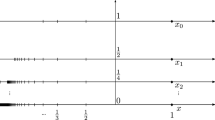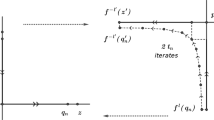Abstract
For a large class of transitive non-hyperbolic systems, we construct nonhyperbolic ergodic measures with entropy arbitrarily close to its maximal possible value. The systems we consider are partially hyperbolic with one-dimensional central direction for which there are positive entropy ergodic measures whose central Lyapunov exponent is negative, zero, or positive. We construct ergodic measures with zero central Lyapunov exponent whose entropy is positive and arbitrarily close to the topological entropy of the set of points with central Lyapunov exponent zero. This provides a restricted variational principle for nonhyperbolic (zero exponent) ergodic measures. The result is applied to the setting of \(\mathrm {SL}(2,\mathbb {R})\) matrix cocycles and provides a counterpart to Furstenberg’s classical result: for an open and dense subset of elliptic \(\mathrm {SL}(2,\mathbb {R})\) cocycles we construct ergodic measures with upper Lyapunov exponent zero and with metric entropy arbitrarily close to the topological entropy of the set of infinite matrix products with subexponential growth of the norm.






Similar content being viewed by others
Notes
Proximality holds if for every pair of points \(x,y\in \mathbb {S}^1\) there is \(\xi \in \Sigma _N\) so that \(|f_\xi ^n(x)-f_\xi ^n(y)|\rightarrow 0\) and \(|f_\xi ^{-n}(x)-f_\xi ^{-n}(y)|\rightarrow 0\) as \(n\rightarrow \infty \).
Furstenberg’s result states the dichotomy “positive Lyapunov exponent versus rigid dynamics”. As we are, by hypotheses, in a non-rigid context, this implies always positive exponent.
Our focus here is on as-large-as-possible entropy. The GIKN construction can be adapted and extended to produce nonhyperbolic measures with zero entropy and full support (see [7, 8, 10]). The method in [5] was modified in [9] to get nonhyperbolic measures with positive entropy and also full support. It was adapted also in [6] to deal with matrix cocycles. The constructions in this paper lay the foundations to construct nonhyperbolic measures with entropy as large as possible and also full support, following the ideas in [8, 9].
As in this paper we consider plenty of sequence spaces, we prefer this terminology.
It holds
$$\begin{aligned} \sup _{\mu :\mu \circ (\pi ^+\circ \pi _1)^{-1}=\nu ^+}h(F_\mathbf {A},\mu ) =h(\sigma ^+,\nu ^+)+\int _{\Sigma _N^+}h_\mathrm{top}(F_\mathbf {A},(\pi ^+\circ \pi _1)^{-1}(\xi ^+))\,d\nu ^+(\xi ^+). \end{aligned}$$It is straightforward to check that \(h_\mathrm{top}(F_\mathbf {A},(\pi ^+\circ \pi _1)^{-1}(\xi ^+))=0\) for every \(\xi ^+\).
The general definition of a coded system allows \(\mathcal {W}\) to be infinite. However, this will not be needed in this paper.
Note that this is slightly weaker than being uniquely decipherable as in [26, Definition 8.1.21].
We use the term simplified to avoid confusion with the term canonical defined above.
In [20], it is assumed that every measure in the sequence is uniformly distributed on a periodic orbit. The results in [32, Chapter 4] imply this criterion, and are in fact considerably more general, but this exact formulation does not appear there. For this reason we state this proposition and, for completeness, also its proof.
References
Avila, A., Bochi, J., Yoccoz, J.-C.: Uniformly hyperbolic finite-valued \({\rm SL}(2,\mathbb{R})\)-cocycles. Comment. Math. Helv. 85, 813–884 (2010)
Avila, A., Viana, M.: Extremal Lyapunov exponents: an invariance principle and applications. Invent. Math. 181, 115–189 (2010)
Barreira, L., Pesin, Y.: Nonuniform hyperbolicity, vol. 115 of encyclopedia of mathematics and its applications. Cambridge University Press, Cambridge (2007). Dynamics of systems with nonzero Lyapunov exponents
Bochi, J., Bonatti, C., Díaz, L.J.: Robust vanishing of all Lyapunov exponents for iterated function systems. Math. Z. 276, 469–503 (2014)
Bochi, J., Bonatti, C., Díaz, L.J.: Robust criterion for the existence of nonhyperbolic ergodic measures. Commun. Math. Phys. 344, 751–795 (2016)
Bochi, J., Rams, M.: The entropy of Lyapunov-optimizing measures of some matrix cocycles. J. Mod. Dyn. 10, 255–286 (2016)
Bonatti, C., Díaz, L.J., Bochi, J.: A criterion for zero averages and full support of ergodic measures. Mosc. Math. J. 18, 15–61 (2018)
Bonatti, C., Díaz, L.J., Gorodetski, A.: Non-hyperbolic ergodic measures with large support. Nonlinearity 23, 687–705 (2010)
Bonatti, C., Díaz, L.J., Kwietniak, D.: Robust existence of nonhyperbolic ergodic measures with positive entropy and full support. Ann. Sc. Norm. Super. Pisa Cl. Sci. (5) 22, 1643–1672 (2021)
Bonatti, C., Zhang, J.: Periodic measures and partially hyperbolic homoclinic classes. Trans. Am. Math. Soc. 372, 755–802 (2019)
Bowen, R.: Topological entropy for noncompact sets. Trans. Am. Math. Soc. 184, 125–136 (1973)
Cowieson, W., Young, L.-S.: SRB measures as zero-noise limits. Ergodic Theory Dyn. Syst. 25, 1115–1138 (2005)
Crauel, H.: Extremal exponents of random dynamical systems do not vanish. J. Dyn. Differ. Equ. 2, 245–291 (1990)
Díaz, L.J., Fisher, T.: Symbolic extensions and partially hyperbolic diffeomorphisms. Discrete Contin. Dyn. Syst. 29, 1419–1441 (2011)
Díaz, L.J., Gelfert, K., Rams, M.: Nonhyperbolic step skew-products: ergodic approximation. Ann. Inst. H. Poincaré Anal. Non Linéaire 34, 1561–1598 (2017)
Díaz, L.J., Gelfert, K., Rams, M.: Entropy spectrum of Lyapunov exponents for nonhyperbolic step skew-products and elliptic cocycles. Commun. Math. Phys. 367, 351–416 (2019)
Díaz, L.J., Gelfert, K., Santiago, B.: Weak\(*\) and entropy approximation of nonhyperbolic measures: a geometrical approach. Math. Proc. Camb. Philos. Soc. 169, 507–545 (2020)
Díaz, L.J., Gorodetski, A.: Non-hyperbolic ergodic measures for non-hyperbolic homoclinic classes. Ergodic Theory Dyn. Syst. 29, 1479–1513 (2009)
Furstenberg, H.: Noncommuting random products. Trans. Am. Math. Soc. 108, 377–428 (1963)
Gorodetski, A.S., Ilyashenko, Y.S., Kleptsyn, V.A., Nalski, M.B.: Nonremovability of zero Lyapunov exponents. Funktsional. Anal. i Prilozhen. 39, 27–38, 95 (2005)
Hutchinson, J.E.: Fractals and self-similarity. Indiana Univ. Math. J. 30, 713–747 (1981)
Kleptsyn, V.A., Nalski, M.B.: Stability of the existence of nonhyperbolic measures for \(C^1\)-diffeomorphisms. Funktsional. Anal. i Prilozhen. 41, 30–45, 96 (2007)
Kwietniak, D., Łacka, M.: Feldman–Katok pseudometric and the GIKN construction of nonhyperbolic ergodic measures (2017)
Ledrappier, F.: Positivity of the exponent for stationary sequences of matrices, in Lyapunov exponents (Bremen: vol. 1186 of Lecture Notes in Math). Springer, Berlin 1986, 56–73 (1984)
Ledrappier, F., Walters, P.: A relativised variational principle for continuous transformations. J. Lond. Math. Soc. (2) 16, 568–576 (1977)
Lind, D., Marcus, B.: An Introduction to Symbolic Dynamics and Coding. Cambridge University Press, Cambridge (1995)
Ruelle, D.: An inequality for the entropy of differentiable maps. Bol. Soc. Brasil. Mat. 9, 83–87 (1978)
Ruelle, D.: Ergodic theory of differentiable dynamical systems, Inst. Hautes Études Sci. Publ. Math., pp. 27–58 (1979)
Tahzibi, A., Yang, J.: Invariance principle and rigidity of high entropy measures. Trans. Am. Math. Soc. 371, 1231–1251 (2019)
Walters, P.: A variational principle for the pressure of continuous transformations. Am. J. Math. 97, 937–971 (1975)
Wang, X., Zhang, J.: Ergodic measures with multi-zero Lyapunov exponents inside homoclinic classes. J. Dyn. Differ. Equ. 32, 631–664 (2020)
Weiss, B.: Single Orbit Dynamics. CBMS Regional Conference Series in Mathematics, vol. 95. American Mathematical Society, Providence, RI (2000)
Yang, D., Zhang, J.: Non-hyperbolic ergodic measures and horseshoes in partially hyperbolic homoclinic classes. J. Inst. Math. Jussieu 19, 1765–1792 (2020)
Yoccoz, J.-C.: Some questions and remarks about \({\rm SL}(2,\mathbf{R})\) cocycles. In: Modern Dynamical Systems and Applications, pp. 447–458. Cambridge University Press, Cambridge (2004)
Author information
Authors and Affiliations
Corresponding author
Additional information
Communicated by C. Liverani.
Publisher's Note
Springer Nature remains neutral with regard to jurisdictional claims in published maps and institutional affiliations.
This research has been supported [in part] by CAPES – Finance Code 001, by CNPq-grants, CNPq Projeto Universal, and E-16/2014 INCT/FAPERJ (Brazil) and by National Science Centre Grant 2019/33/B/ST1/00275 (Poland). The authors acknowledge the hospitality of IMPAN, IM-UFRJ, and PUC-Rio.
Appendix: Proof of Proposition 11.1
Appendix: Proof of Proposition 11.1
Given \(\phi :X\rightarrow \mathbb {R}\), denote
Given \(\varepsilon >0\), denote the upper topological limit of \((\Upsilon _{n,\phi ,\varepsilon })_n\) by \(\Upsilon _{\phi ,\varepsilon }\), that is,
We use the following fact that is straightforward to check.
Claim 11.2
For every continuous \(\phi :X\rightarrow \mathbb {R}\) and \(\varepsilon >0\) it holds
Lemma 11.3
For every continuous \(\phi :X\rightarrow \mathbb {R}\) and \(\varepsilon >0\) there exists a set \(\Xi _{\phi ,\varepsilon }\subset \Upsilon _{\phi ,\varepsilon }\) such that \(\varrho (\Xi _{\phi ,\varepsilon })>1-\varepsilon \) and
for every \(x\in \Xi _{\phi ,\varepsilon }\).
Proof
Given \(\phi \) and \(\varepsilon \), let \(L=L(\phi ,\varepsilon )\) and for \(\ell \ge L\) let \(N=N(\ell )\) be as in the hypothesis of the proposition. By Claim 11.2 and our hypothesis,
Every \(x\in \Upsilon _{\phi ,\varepsilon }\) is the limit of some sequence of points \(x_i\) in \(\Upsilon _{n_i,\phi ,\varepsilon }\), \(n_i\ge \ell \). Hence, for \(n_i\ge \ell \) sufficiently large, it holds
By our hypothesis on \(x_i\in \Upsilon _{n_i,\phi ,\varepsilon }\), it holds
Hence, for every \(x\in \Upsilon _{\phi ,\varepsilon }\) and \(\ell \ge 1\) sufficiently large it holds
Therefore, with the notation above, for every \(x\in \Upsilon _{\phi ,\varepsilon }\)
Applying the Birkhoff theorem to the invariant measure \(\varrho \), we get a set Z with \(\varrho (Z)=1\) so that at every \(z\in Z\) it holds \(\overline{\phi }(z)=\underline{\phi }(z)\). By the above, for every \(z\in \Xi _{\phi ,\varepsilon }\mathop {=}\limits ^{\mathrm{def}}Z\cap \Upsilon _{\phi ,\varepsilon }\) it holds \(|\overline{\phi }(z)-\phi (\varrho )|<3\varepsilon \) and \(\varrho (\Xi _{\phi ,\varepsilon })=\varrho (\Upsilon _{\phi ,\varepsilon })>1-\varepsilon \). This proves the lemma.
\(\square \)
Let us now prove that \(\varrho \) is ergodic. Take a dense set of continuous functions \(\{\phi _k\}_k\) and a summable sequence of positive numbers \((\varepsilon _k)_k\). As
by the Borel–Cantelli lemma, there is a set \(\Upsilon \) satisfying \(\varrho (\Upsilon )=1\) such that every \(x\in \Upsilon \) is contained in only finitely many sets \(\Upsilon _{\phi _k,\varepsilon _k}^c\). It follows that for every continuous \(\phi \) and \(x\in \Upsilon \) Birkhoff averages of \(\phi \) converge to \(\int \phi \,d\varrho \). This implies that \(\varrho \) is G-ergodic.
\(\square \)
About this article
Cite this article
Díaz, L.J., Gelfert, K. & Rams, M. Variational Principle for Nonhyperbolic Ergodic Measures: Skew Products and Elliptic Cocycles. Commun. Math. Phys. 394, 73–141 (2022). https://doi.org/10.1007/s00220-022-04406-w
Received:
Accepted:
Published:
Issue Date:
DOI: https://doi.org/10.1007/s00220-022-04406-w




